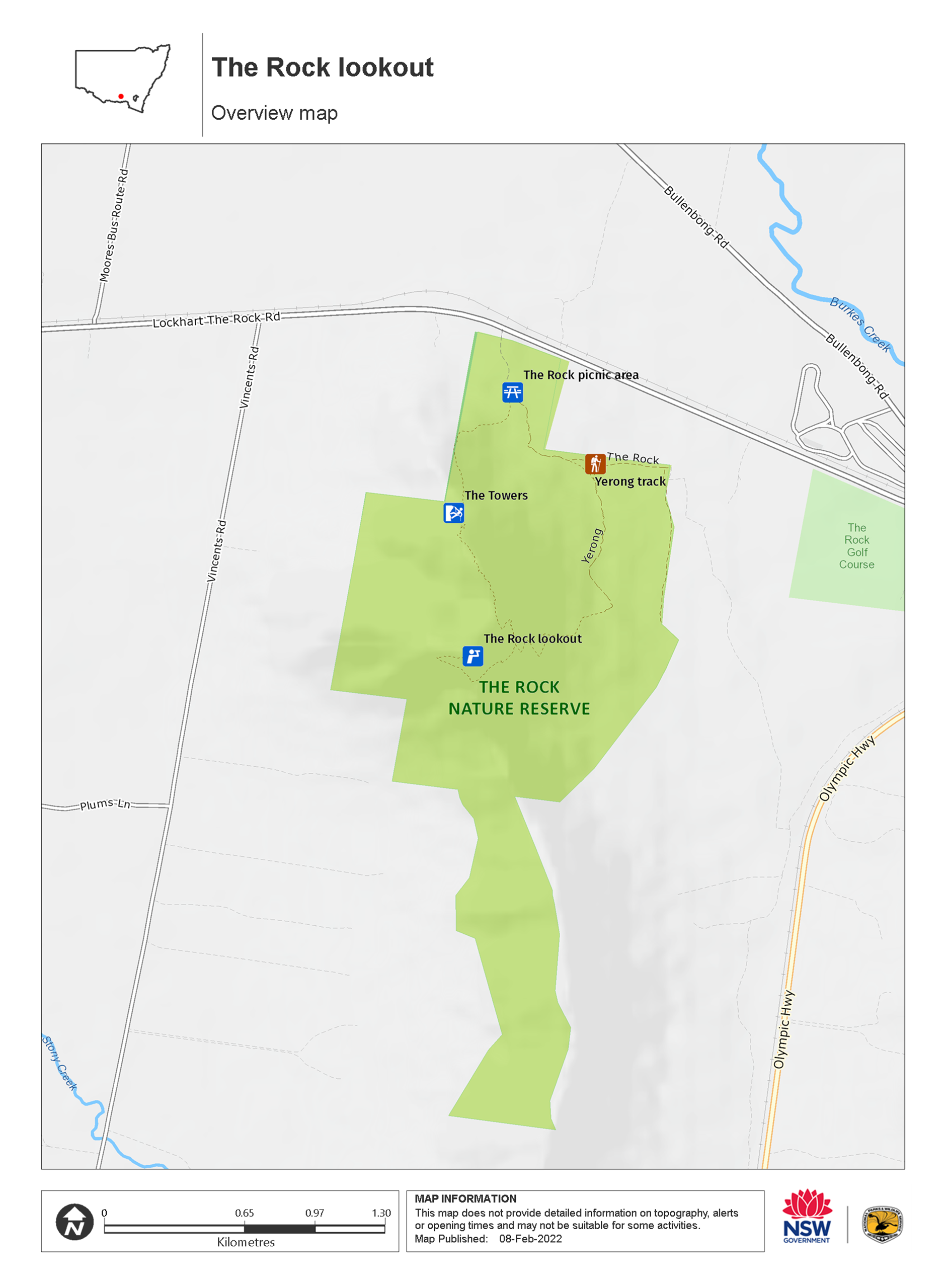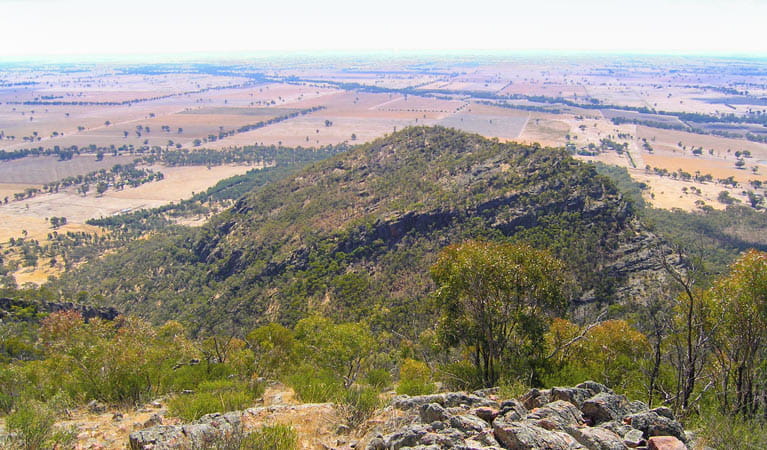The Rock lookout
The Rock Nature Reserve - Kengal Aboriginal Place
Overview
The Rock lookout is the terminus point of Yerong walking track, offering stellar scenic views over the surrounding area with great birdwatching opportunities.
- Type
- Lookouts
- What to
bring - Hat, drinking water, sunscreen
- Please note
- The weather in the area can be extreme and unpredictable, so please ensure you’re well-prepared for your visit.
- Remember to take your binoculars if you want to go birdwatching
The Rock lookout offers spectacular views, comprises the remains of an old trig point and is a rewarding way to end your hike along Yerong walking track. On a clear day you can see to Galore Hills in the west, and the snow-capped peak of Mount Kosciuszko far in the distance, as well as the Bogong Range and Victorian Alps.
The Rock lookout is a great place for birdwatching, as native peregrine falcons nest at and around The Towers. Artistically inclined travellers might like to bring a sketchbook, or perhaps a camera to capture scenery.
Keep your eyes peeled for wildflowers like bluebells and yellow wattle bloom. Near the bare cliff tops, Dwyer’s mallee gum and drooping sheoak have taken root. After admiring the view, head for The Rock picnic area down below and enjoy a leisurely, well earned lunch.
Map

Map legend

Local alerts
For the latest updates on fires, closures and other alerts in this area, see https://www.nationalparks.nsw.gov.au/things-to-do/lookouts/the-rock-lookout/local-alerts
General enquiries
- National Parks Contact Centre
- 7am to 7pm daily
- 1300 072 757 (13000 PARKS) for the cost of a local call within Australia excluding mobiles
- parks.info@environment.nsw.gov.au
Park info
- in The Rock Nature Reserve - Kengal Aboriginal Place in the Murray-Riverina region
The Rock Nature Reserve – Kengal Aboriginal Place is always open but may have to close at times due to poor weather or fire danger.
Visitor info
All the practical information you need to know about The Rock lookout.
Maps and downloads
Learn more
The Rock lookout is in The Rock Nature Reserve - Kengal Aboriginal Place. Here are just some of the reasons why this park is special:
Geological significance

The reserve sits on the boundary between two major biophysical regions: the Riverine Plains and the western slopes of the Eastern Highlands. This geographic mix gives the area a terrific diversity of landscapes and animal habitats. The Rock itself, unique in the district, is the result of a pressure uplift of sedimentary materials, and is the highest point of a hogback ridge running north to south (The Rock is at the northern end). The summit stands 364m above the surrounding plains.
- Aboriginal special places guided tours Join Bundyi Cultural Tours in The Rock Nature Reserve - Kengal Aboriginal Place, near Wagga Wagga to explore ancient Wiradjuri culture in a beautiful and timeless landscape.
- The Towers The Towers is a 100m stretch of the north-east face of The Rock, open to rock sports and also popular with photographers and birdwatchers who want to view peregrine falcons.
Living Aboriginal culture: Kengal

The dual name of the nature reserve (since 2005) acknowledges a Wiradjuri cultural presence that stretches back many generations. The Rock is also known as Kengal (meaning ‘sloping hill’), a Dreaming place, lookout, and ceremonial site for the Wiradjuri People and their descendants. It was once used for male initiation rituals. Traditional lore has it that Kengal was created by Baiame, the creator who also taught the Wiradjuri People how to make fire and spears. When settlers arrived in the area, stories go, Baiame left his male and female dingo (Mirrigan) companions, who lay in wait for Baiame’s return, forming The Rock.
- Aboriginal special places guided tours Join Bundyi Cultural Tours in The Rock Nature Reserve - Kengal Aboriginal Place, near Wagga Wagga to explore ancient Wiradjuri culture in a beautiful and timeless landscape.
'The Hanging Rock’

Charles Sturt first saw The Rock in 1829, though the area wasn’t settled further by Europeans until 1874. They called the remarkable geological feature ‘The Hanging Rock’ because of an overhang on its eastern face. This collapsed in 1874, however, leading to the adoption of its current name – simply, ‘The Rock’. For much of its modern life, the feature has sat on Crown land, and from 1891 its lower slopes were quarried for road base material to provide ballast on a Sydney-Melbourne rail line.

